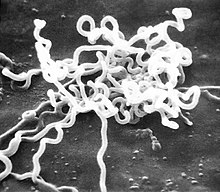Syphilis
Syphilis (IPA: ˈzyːfilɪs,![]() ), also called lues (venerea) (IPA: ˈluːɛs,
), also called lues (venerea) (IPA: ˈluːɛs, ![]() ), hard chancre and Schaudinn's disease or Schaudinn's disease, is a chronic infectious disease belonging to the group of sexually transmitted diseases. The causative agent of syphilis is the bacterium Treponema pallidum subspecies pallidum. Syphilis is transmitted mainly during sexual intercourse through mucosal contact and exclusively from person to person. During pregnancy and childbirth, an infected mother can infect her child (syphilis connata).
), hard chancre and Schaudinn's disease or Schaudinn's disease, is a chronic infectious disease belonging to the group of sexually transmitted diseases. The causative agent of syphilis is the bacterium Treponema pallidum subspecies pallidum. Syphilis is transmitted mainly during sexual intercourse through mucosal contact and exclusively from person to person. During pregnancy and childbirth, an infected mother can infect her child (syphilis connata).
The appearance of the disease is varied. Typical is an onset with painless mucosal ulcers and swelling of the lymph nodes. Some of those infected develop a chronic course characterised by multiple skin and organ infestations. In the final stage, the central nervous system is destroyed. The diagnosis is mainly made by the detection of antibodies. Syphilis is curable by the administration of antibiotics, including penicillin. The discovery and subsequent availability of antibiotics in sufficient quantities led to a marked decline in syphilis in the 20th century. Since the 1990s, however, there has been a renewed increase in the number of cases detected.
Since 2010, there have been 3 to 6 new infections per 100,000 inhabitants per year in Germany. The direct or indirect detection of the pathogen Treponema pallidum is not to be reported by name in Germany. There is an obligation to report the pathogen and disease in Switzerland and a limited obligation to report the disease in Austria.
Syphilidology is the study of syphilitic diseases.

Depiction of a syphilitic attributed to Albrecht Dürer (pamphlet with the doctrinal poem by the physician Dietrich Ulsen, Nuremberg 1496)
Etymology and names
The first documented outbreak of syphilis in Europe occurred in 1494 or 1495 in Naples, Italy, during the French invasion in the Italian War of 1494-98. At that time, the disease was thought to have been spread by French troops, which is why it first became known as French disease.
The word syphilis is first found in 1530 in the title of a poem by the Veronese physician Girolamo Fracastoro (1483[?]-1553), called Syphilis, sive Morbus Gallicus (Syphilis, or the French Disease). In it is told the story of the shepherd Syphilus, who was punished for blasphemy (he erected forbidden altars) with a new disease, syphilis. The name Syphilus is the Latinized form of the ancient Greek name Σύφιλος Sýphilos, which can be translated as "loving pigs" (σῦς sŷs, German 'pig', φιλεῖν phileîn, German 'to love'). Fracastoro probably borrowed the name Syphilus from ancient mythology. In Ovid, the second son of Niobe is called Sipylus. Why he chose this name is unknown.
The Latin word luēs means "plague", "mischief"; venereus comes from humanistic Latin, derives from venus, love-lust, love-pleasure' and means "concerning sexual intercourse". In 1526, with the intention of giving the disease a neutral name instead of the term "French disease", which denigrated the French, the French physician Jacques de Béthencourt coined the name Morbus veneris ("disease of Venus"). Syphilis was also frequently referred to as the lust disease.
In addition, several hundred other names for syphilis have been handed down from history. These refer to the external appearance (Morbus pustulatus), to fallen body parts, to saints (Job, Rochus and others), to supposed causes (Lues venera, Lues aphrodisiaca) or to the supposed country of origin. Thus syphilis has been named in various European languages as Neapolitan, Italian, French, Spanish, Castilian, English, Scottish, or Polish, among others, depending on the country from which the disease was supposedly introduced into the respective linguistic circle. In common parlance syphilis has also been called "great blisters" and by similar terms.

History of Syphilus, engraving by Jan Sadeler from the 16th century
Pathogen
Treponema pallidum subspecies pallidum is a gram-negative bacterium of the genus Treponema in the family Spirochaetaceae. Treponema pallidum (formerly called Spirochaeta pallida) is spirally coiled. In the dark-field microscope, which is also used for detection, it shows rotations around the longitudinal axis and bending movements, but no independent locomotion. The replication time is about 36 hours.
The only reservoir host is humans, for whom it is obligately pathogenic, i.e. healthy immunocompetent people also become ill. T. pallidum survives outside the body for only a short time, reduced oxygen concentration prolongs survival (microaerophilic bacterium). In vitro culture of Treponema pallidum is not possible, as it requires nutrients from the human organism, which it cannot produce itself. Only rabbit testes can be used for cultivation.
In addition to Treponema pallidum, the genus Treponema includes other pathogens that are pathogenic (harmful) to humans: T. pallidum subspecies endemicum causes the endemic disease bejel, also called non-venereal or extragenital syphilis, in Africa and the Middle East (see below). T. pallidum subspecies pertenue causes frambosia, a protracted infectious disease associated with skin and bone lesions (manifestations), in Africa, Asia, and Latin America. Treponema carateum causes pinta in Central and South America. This is a skin disease with recurrent hyperpigmented lesions predominantly on the arms and legs that heal scarred. T. vincentii can cause plaut vincent angina as part of a mixed infection.
Non-pathogenic Treponema species are T. denticola, T. minutum, T. refringens and T. phagedenis, which are found in the normal site flora of the mouth, digestive tract as well as the genital organs. In the case of microscopic pathogen detection, they may contribute to confusion.

Treponema pallidum (electron micrograph)
Questions and Answers
Q: What is syphilis?
A: Syphilis is a sexually transmitted infection caused by a bacterium called Treponema pallidum.
Q: How is syphilis usually spread?
A: Syphilis is usually spread by sexual contact, but it can also be passed from mother to fetus during pregnancy or childbirth.
Q: What are the stages of syphilis?
A: The four stages of syphilis are primary, secondary, latent, and tertiary. Each stage has different signs and symptoms.
Q: What happens in the primary stage of syphilis?
A: In the primary stage of syphilis, a person usually just has a wound on their skin called a "chancre."
Q: How is syphilis diagnosed?
A: Syphilis is usually diagnosed with blood tests and sometimes the bacteria that causes it can be seen under a microscope.
Q: Can people with syphilis be cured?
A: Most people who have syphilis can be treated and cured with antibiotics.
Q: How common was syphisis before penicillin became available in the 1940s?
A: Before penicillin became available in the 1940s, more than 12 million people around the world had gotten syphillis.
Search within the encyclopedia